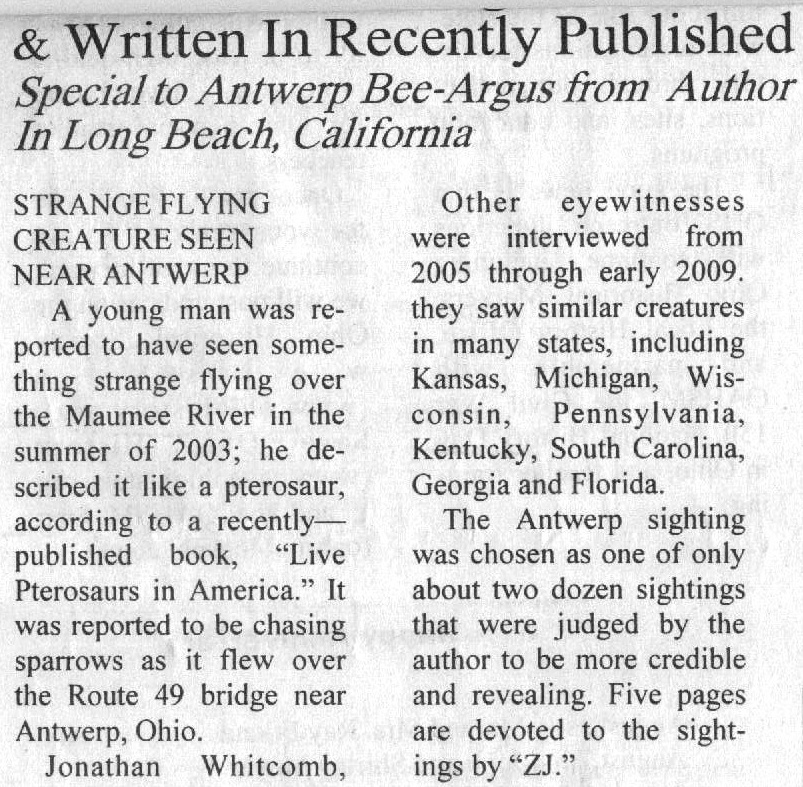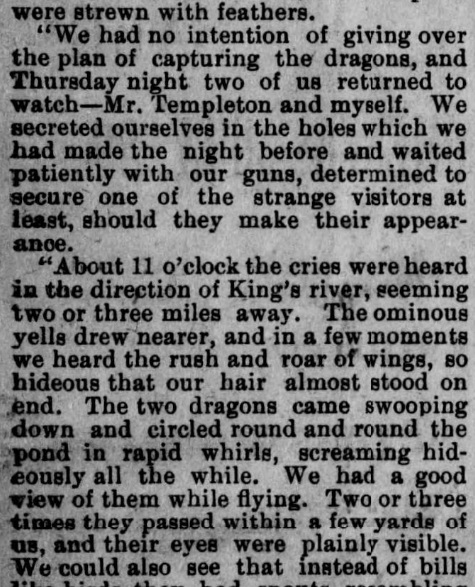Newspapers do, on occasion, publish reports of encounters with flying creatures described like pterosaurs, although eyewitnesses may use words like “pterodactyl” or “flying dinosaur.” Let’s begin with a 2004 article in the Papua New Guinea newspaper Post-Courier.
COULD humble Siassi Islands in Morobe Province hold the answer to studies into prehistoric times? Many in the scientific community would like to know the answer to this question. [When I was interviewed by the newspaper reporter, I did not bring up the word “prehistoric” or the concept of old-age creatures; she must have done some research after our interview.]
Among them is Jonathan Whitcomb, an American forensic videographer, who arrived on Siassi to investigate the Ropen — perhaps the only surviving pre-historic animal to be found in the world. [The reporter definitely did not get that idea from me.] Mr Whitcomb has been on Umboi Island, the main island of the Siassi Islands, trying to capture on film the creature.
. . . “Ropen” is the local *Kowai (Siassi) name for the creature and is also the name known for the animal among the [paleontology] and the general scientific communities [I never told her that]. * [“Kovai” is a more common spelling.]
. . . Yesterday, Mr Whitcomb and his local guide showed up at the Post Courier office in Lae to tell of his study. He said the stories were not just myth but actual sightings of a real animal and he was there to try to capture it on film. Mr Whitcomb said the creature had features of a giant flying fox, with a mouth like that of a crocodile and wings that span up to 7m. It has been sighted by many of the islanders, he said, and he had travelled there after hearing about it.
Antwerp, Ohio, Pterosaur Sighting
The Antwerp Bee-Argus weekly newspaper (Antwerp) published the following on Aug 5, 2009:
Special to Antwerp Bee-Argus from author in Long Beach, California [Whitcomb]
Strange Flying Creature Seen Near Antwerp
A young man was reported to have seen something strange flying over the Maumee River in the summer of 2003; he described it like a pterosaur, according to a recently-published book, “Live Pterosaurs in America.” It was reported to be chasing sparrows as it flew over the Route 49 bridge near Antwerp, Ohio.
Jonathan Whitcomb, author of the book, interviewed the young man . . . The animal appeared to be ten feet long, including a long tail. Whitcomb asked him about feathers, but he replied, “absolutely no feathers.” But something else made it different from any bird: It had teeth.
. . . Pterosaurs are sometimes called “pterodactyls” and have been thought by many scientists to have gone extinct many millions of years ago. Whitcomb believes the Maumee River creature may be like the ropen of Papua New Guinea, north of Australia.
.
California Pterosaur in a Newspaper
. . . reports of “dragons” flying over an area south of Fresno [CA], around Selma.
Statistics on Pterosaur Sightings
I know this could seem impossible to many paleontologists: “basal” pterosaurs that fly over our heads at night, sometimes flying in daylight; but consider now the reports of long tails on these flying creatures. Of the total sightings, a long tail was reported in 41% of the reports and no-long-tail in 2%.
Pterosaur Sighting in South Carolina
Susan Wooten’s shocking encounter, in daylight, while she was driving on a country highway




